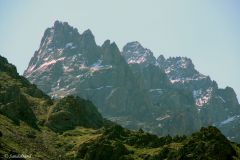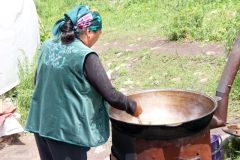Even a poor country has its proud monuments, and being the capital of Kyrgyzstan, Bishkek has a fair number of them. In addition, there is mighty mountain scenery to the south.
This is part of a series of articles from a journey to the Central Asian republics of Uzbekistan and Kyrgyzstan in June 2014.
Introduction
Central Asia is a vast and varied territory, once famous for prospering from the Silk Road caravans. Sandalsand’s journey into this region has been described in a series of articles from Uzbekistan and Kyrgyzstan. We have finally come to the end, chapter nine.
I will here offer a few glimpses into what Bishkek has to offer a visitor arriving for a couple of days, and I will include an excursion to the magnificent national park of Ala Archa.
Bishkek
The capital city is less than 200 years old but has even younger physical structures to attract visitors. It was never a stronghold on the Silk Road but was nonetheless established as a fort, gradually developing into the capital of the Kyrgyz republic during the days of the Soviet Union.
Much of the architecture and physical layout is from the Soviet era. Large buildings, wide avenues and parks bearing no special sign of showing off a historical tradition from this part of the world.
The Ala-Too square in the centre has all the looks of a capital, with important buildings lining it and a changing of goose-stepping guards taking place at regular intervals very much in the same manner as elsewhere in this part of the world.
The park next to the square is much more enjoyable, with high trees providing a good shade from the scorching summer sun, and – on the day of our visit – a market where local painters had set up their stands to sell their artwork.
Continuing through the park we passed the ubiquitous monument to the Red Army, and then a Opera House with classical features.
The presidential palace, or main government building, is called the White House. It has since the independence seen several presidents moving in, and then out after a few years. They seem to have a habit of emptying the state coffers before vanishing to Minsk or Moscow after a public uproar. Kyrgyzstan is a very corrupt country.
Apart from that, the streets are clean, the billboards are large, the young are dressed like in the West, international brands are available in the stores, and all in all the capital city of Kyrgyzstan is evolving into just another international big city.
Ala Archa
Bishkek’s fortune is its setting. It is situated on the very flat plain on the northern edge of Kyrgyzstan, 800m above sea level. The steppe continues north into Kazakhstan, only kilometres away.
To the south the northern parts of the Tian Shan mountain range are easily visible from the city, especially if you get a hotel room high up in the air.

A room with a view. From Bishkek towards the Kyrgyz Ala-Too mountain range
We went for a day excursion into those mountains. What a place!
The national park is only a 45 minutes drive away from the city. It seemed like a very popular place for a family picnic. There were even some yurts and cabins set up for the privileged few.
For the rest of us, at least for my group of Norwegians, we laid our eyes on the river running down the valley and on the mighty mountains surrounding us. This time of year at least, the summits were still covered by snow. I would suppose some of it never melts due to the altitude.
We went for a hike on gravel roads and eventually trails into the valley for a couple of hours. Obviously, there is more to see and far longer to hike. I had learned that the Norwegian Trekking Association for some reason has exported its success at home (read this article) and set up a string of mountain lodges and marked trails in Kyrgyzstan.
It was a beautiful day in some really awesome scenery.
The map
This is part of a series of articles from a journey to the Central Asian republics of Uzbekistan and Kyrgyzstan in June 2014.
On the map below Leg 1 goes from Tashkent (A) west to Khiva (E) in Uzbekistan. Then a flight back to Tashkent (A) before Leg 2 to Bishkek (F) in Kyrgyzstan. This article is the third and last from Leg 2.
Read more
The chapters:
(1) In search of the ancient Silk Road
(2) The monumentalism of Tashkent
(4) Shakhrisabz and the birth of a nation
(5) The Emir of Bukhara and the lost camels
(6) The magnificent oasis of Khiva
(7) The fertile Fergana Valley
(8) Nomadic life on the mountain passes of Kyrgyzstan
(9) Bishkek and the valley of Ala Archa
In addition we visited five sites on the World Heritage List all described in separate articles.
Images to enjoy
Here are some images from the described journey. Click to expand and browse.
















